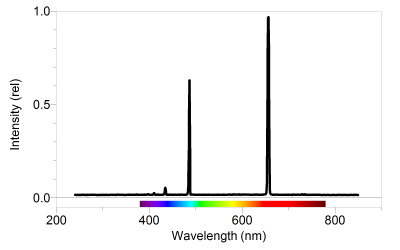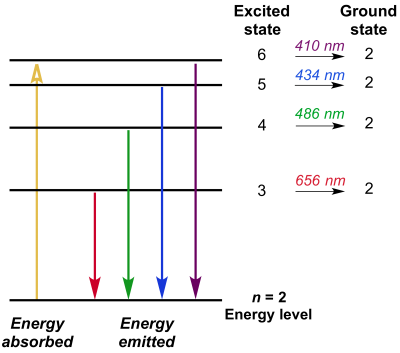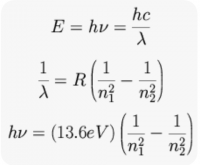Ch7 lec 2
(4/22/20, bes)
Additional Light Lab Info
In our lab discussion i did not introduce you to the "photodiode array" (PDA) <-- not "public display of affection" --> instrument. A PDA is very similar to an electronic version of a "glass prism." A prism separates the wavelengths of light into the individual color components; when a rainbow is observed, the tiny water droplets are acting as a prism. If we were to direct "white" light into the PDA (which contains a prims and more), then you could measure/collect a "spectrum" similar to the "broad," featureless spectrum (red) on the far right figure...note the wavelengths are in nanometers (nm). This figure is complicated by the fact that these authors used a technique to separate the light prior to it entering the PDA, so that is why there are all of the other "narrow" spectra also shown.
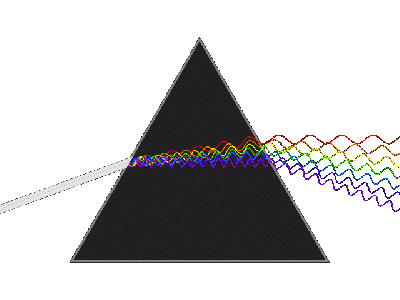 |
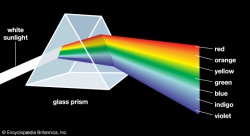 |
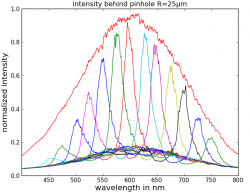
|
Sorry, i know this is a little confusing...hang in there...here is another example...I think you should be familiar with LEDs (light emitting diodes)...they come in different colors. If we were to meet in person for the "Light Lab", then i would have shown you the PDA spectrum of the LEDs. In the figure below, the red, green, and blue LEDs when shown into the PDA would result in a spectrum with a peak at 650 nm - red, 570 nm - green, and 480 nm - blue (pls note, there are 3 separate spectra on this one graph).
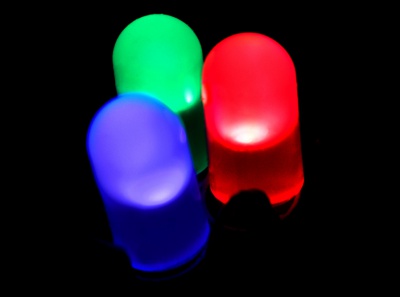 |
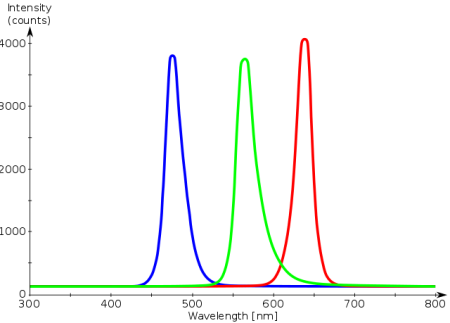
|
Problem very similar to #2 from lab
Complete the following table:
| Wavelength (nm) | Wavelength (m) | Frequency (1/s) | Energy (J) |
| 650 | |||
| 570 | |||
| 480 |
Sec 7.3: Bohr's Theory of the Hydrogen Atom
An experiment i would have done with you in the lab would have involved the experimental setup shown in Figure 7.6 of your text. The light source would have been a similar to a small fluorescent tube, but the gas inside of the tube would have been hydrogen gas (H2) (see Figure 7.7). Now you don't really need to know this level of detail, but when a high voltage is applied across the "discharge tube" the H2 gas breaks into individual H-atoms that then produce the "emission spectrum"...show in a "line spectrum" in Figure 7.6. The real emission spectrum would look like this...with emission lines at 410 nm (very small), 434 nm (small), 486 nm (medium), and 656 nm (largest):
So why is the emission spectrum of the hydrogen atom look like it does? The rest of this section explains this complex answer...read carefully...
The observation of a single emission line, like the 656 nm emission line, implies that light with an energy of 3.03e-19 J is emitted (you can do this nm --> energy clac). In physics we learned about the conservation of energy, so if 3.03e-19 J of energy is given off, then something had to lose this energy. After much refinement of experiments and data analysis the following Bohr' model (theory) for the hydrogen atom was proposed.
- - This model/theory has been called the "planetary model" since it look a bit like the planets in our solar system.
- - The single electron in a H-atom must exist in an energy state (or at an energy level <--these mean the same thing).
- - If the electron is excited to a higher energy state/level, then when it relaxes back down to its original state/level it give off energy (E) in the form of light (λ).
- - Since the H-atom has 4 emission lines (410, 434, 486, 656 nm) then there must be at least 5 energy levels (in the diagram below, n=2, n=3, n=4, n=5, and n=6). STUDY THIS FIGURE
- --> 656 nm is equal to the difference in energy between the levels labeled n=2 and n=3...656 nm = 3.03e-19 J.
- --> 486 nm is equal to the difference in energy between the levels labeled n=2 and n=3...656 nm = 4.09e-19 J.
- --> 434 nm is equal to the difference in energy between the levels labeled n=2 and n=3...656 nm = 4.58e-19 J.
- --> 410 nm is equal to the difference in energy between the levels labeled n=2 and n=3...656 nm = 4.85e-19 J.
TAKE HOME POINT: the emission line wavelength/energy is equal to the difference between the energy levels (ΔE).
An equation called the Rydberg Equation was concurrently (? <-- i need to explore this history) developed (see eq. 7.6)...and it is shown in a few different ways:
- where R = RH = Rydberg constant and is given in many different units (but they are all the same number)...
- - RH = 2.18e-18 J
- - RH = 109,677.581 1/cm
- - RH = 10,967,758.1 1/m
- - RH = 13.6 eV <-- electron-volt
Electronic Structure Worksheets
(These worksheets will not be collected. A similar WA will be generated by Friday)
